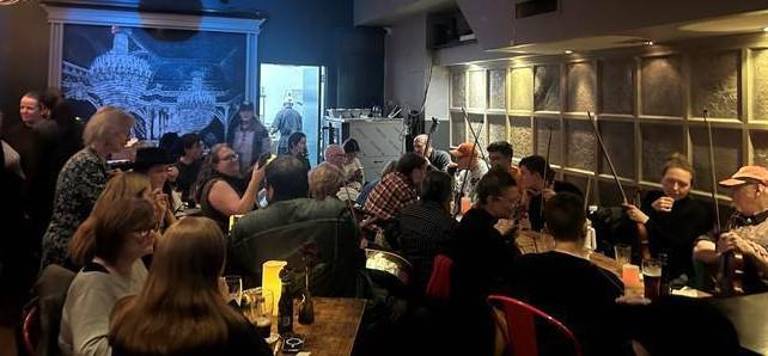Irish Traditions Kept Alive by Free Music Sessions in Manhattan Pubs
Starting at Mary O’s in Alphabet City a decade ago, a dedicated group of musicians is keeping traditional Irish music alive with Thursday-night sessions. On different days of the week, sessions can now be found in more than a half-dozen pubs across Manhattan.

It’s difficult to move around Mary O’s on a Thursday night. Like any other pub, rounds of Guinness and fish and chips are served, but that’s the least important part of the night. Thursdays at the Alphabet City venue are reserved for traditional Irish sessions, or “seisiuns,” as they are known in Irish, a time when musicians unpack their instruments to perform jaunty and haunting old tunes.
Each session is different. But the concept has remained the same since its origins from 1700s Ireland: A social space opens its doors to musicians, who choose the songs and expect other performers around the table to join in. Although sessions aren’t widely known outside the Irish community, the legacy continues every night across strings of pubs in New York City. Musicians, drawn in by tradition or passion, keep the lore alive and evolving.
“There’s a lot of heart in the room,” said Mary O’Halloran, owner of Mary O’s. Two players approached her 11 years ago and asked if they could start a friendly open session for beginners. “Ours was different. It’s people just beginning to play. They wanted somewhere beginners could come, sit, and play in the session as it was going on, but under the guidance of the leaders.”
Mary O’s on a Thursday isn’t the only destination for jam sessions. Musicians gather at Landmark Tavern in Hell’s Kitchen or Hartley’s in Clinton Hill on Mondays. Tuesdays are reserved for Slainte in the Bowery, and Wednesdays at Grace’s in Chelsea or Paddy Reilly’s in Kips Bay. On Fridays, the music can be found at Wheeltapper Pub near Grand Central and on Sundays at The Laurels on East 14th Street.
“There’s accents in the way people create these melodies, the way they ornament them,” said Don Meade, a fiddle player who leads a session at the Landmark Tavern on Mondays. If players don’t know the song, they sit idle, registering the tune for the next time, while others who recognize the notes jump right in.
They play Irish melodies from the countryside, music that is mostly made for dancing, but other tunes can be more somber. The sessions attract a diverse group both around the table and in the audience. Pubgoers tap their feet and chat with friends in the background, but the music takes center stage to keep a beloved tradition alive for future generations.
Despite the decreasing numbers of Irish immigrants in the US, the traditional Irish session scene is thriving in New York City. Every night, mostly in Manhattan, with spillover into Bronx and Brooklyn pubs, musicians gather their fiddles, Celtic harps, guitars, tin whistles, tenor banjos, and bodhráns.
The concept of these music sessions hit the United States in the 1960s during the folk music revival. Waves of Irish immigrants and their children gathered in community spaces and pubs to celebrate their traditional music and Irish folklore.
But immigrants from Ireland are significantly fewer compared to previous generations.
Between 1841 and World War II, 4.5 million Irish immigrants entered the US, but the migration slowed down under the Immigration Nationality Act of 1965. As a result, a wave of undocumented Irish immigrants entered the states in years that followed. As of 2022, only 123,000 out of 32.7 million Irish Americans were born in Ireland.
“Without the continuing reinforcement of immigrants from Ireland, I don’t know how it’s going to work out for Irish musical art,” Meade, the fiddle player, said. “People who provided the energy and the new tunes were people who moved from Ireland and their kids.”
But Meade said Irish musicians aren’t too concerned about losing their culture. Technology has only strengthened the accessibility of Irish music, especially because players can record tunes they’ve never heard before or look up tutorials online. And pubs receive a steady stream of around 20 musicians per session, filled with both regulars and visitors. There’s also an increase in diversity among performers who don’t have Irish ancestry at all.
“I didn’t have a language for what this music was,” said Sara Perle, a fiddler from Canada who plays at Mary O’s. Still, she found it easy to join the community.
“There’s more diversity than people realize,” Perle said, which was not the case as recently as 10 years ago, she added. Perle values the opportunity to collaborate with other musicians and socialize. “I’m not playing for somebody. I’m playing with somebody.”
The scene is thrilled that non-Irish musicians have become involved. “In some ways, it was very closed off, but the world has gotten more tolerant and accepting of people on the outside,” said Winifred Horan, a fiddler in the Irish band Solas. “Art is, I think, the most accessible and the most welcoming to outsiders.”
Because everyone plays the same melody at the same time, open sessions create cohesion. “It fosters a friendly, open dynamic because everybody’s doing it together,” said Rogan McCally, another fiddler who plays four days a week.
And younger generations are living up to the connection. Gabriel McDerment, 21, plays the banjo and learned about sessions through a professor. Although he’s one of the youngest in the group, he doesn’t see the music dying down.
“The music is in the here, the music is in the now,” McDerment said. “It’s because of that, not only will people come back, but no matter if we have a pub to play in tomorrow or not, those experiences will guide us into what’s next.”
The pub session “fosters a friendly, open dynamic because everybody’s doing it together.” — Fiddler Rogan McCally of the Irish music “seisiuns”